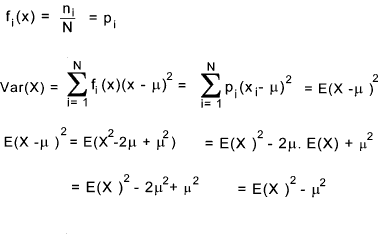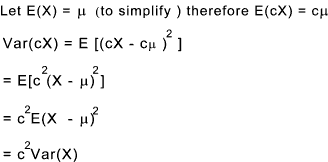Introduction
The expectation E(X) is simply defined as the sum of the products of all values by the respective probability. There expectation is
valid for discrete and continuous distributions. The Expectation is actually synonymous with the
mean value.

Symbols
In the notes below the probability distributions relate to probability of successes. In practice
they could equally relate to failures, or outcomes with desired values ( dice throw = 6)
X = random variable
μ = population /distribution mean
E(X) = expected mean of random variable
Var(X) = variance of random variable
σ 2 = Distribution variance
σ = Distribution standard deviation
f(x) = probability density function
P(k) = probability that in that k successes occur in n trials
F(x) = probability distribution function. ***
xm = arithmetic mean of sample
|
sx 2 = variance of sample
sx = Standard deviation of sample
N = Number of items in distribution
n = number of trial/ sample items
M = Number of success items in options (= pN)
k = number of successes
p = probability of success 0 < p < 1
pi = probability of x = xi
xi = discrete value of random sample
|
Notes
Considering a typical probability distribution as shown below.
The expectation is effectively the horizontal position of the centroid of the area.

Example 1:
It is clear that if four coins are tossed the expectation of heads resulting = 2. This is confirmed as shown below
The probability of 0 heads = (1/2)4 = 1/16
The probability of 1 heads = 4.(1/2)4 = 1/4
The probability of 2 heads = 6.(1/2)4 = 1/4
The probability of 3 heads = 4.(1/2)4 = 1/4
The probability of 4 heads = (1/2)4 = 1/16
E(X) = 0.(1/16) + 1.(1/4) + 2(3/8) + 3(1/4) + 4(1/16) = 2
Example 2:
Expectation on tossing a fair dice.
E(X) = 1.(1/6) + 2.(1/6) + 3.(1/6)+4.(1/6)+ 5.(1/6)+ 6.(1/6) = 21/6 = 3,5 ( Half way between 3 and four)
Properties of Expected values
1) E(aX) = a.E(X)
2) E(aX + b) = aE(X) + b
3) Var(X) = E(X - μ 2 ) = E(X 2) - μ 2 = E(X 2) - [E(X )]2
4) E(X+Y) = E(X) + E(Y) ... X and Y are two random variables.
5) E(X.Y) = E(X).E(Y) ...X and Y are two independent variables
6) Var(cX) = c2 Var(X)
7) Var(X +Y) = Var(X) + Var(Y).... X and Y are two independent variables
8) Var(X +c) = Var(X)
Proof of 2) E(aX + b) = aE(X) +b

Proof of 3) Var(X) = E(X)2 - μ 2

Proof of 6) Var(cX) = c2) Var(X)

|




